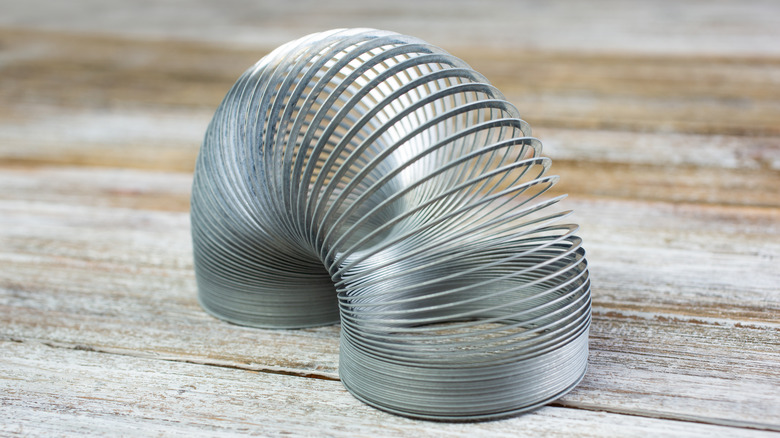Attract More Birds With A Feeder You Can DIY From An Old Slinky
No spring left in that old Slinky? Well, bird lovers looking for an easy and budget-friendly way to attract feathered friends can give their overstretched Slinky a second life by repurposing it into a unique peanut feeder. This simple DIY project transforms a classic toy into a functional bird feeder that blue jays, cardinals, and even curious squirrels will enjoy. (Conversely, the power of the Slinky can help deter squirrels from your bird feeders.) Unlike traditional bird buffets, this Slinky-based design allows for easy peanut refilling while maintaining a lightweight and flexible structure.
To start, you'll need a 10-inch metal wreath frame, a metal Slinky, zip ties or bread ties, and whole peanuts. The key to success is keeping the wreath frame open, making sure the peanuts can be easily inserted. Since the spacing between Slinky coils is crucial, using a 10-inch frame prevents gaps that would cause peanuts to fall through. Reinforcing the Slinky every five rings with ties helps support the weight of the peanuts and keeps the structure balanced when hanging outdoors.
Building and hanging your DIY bird feeder
Begin by cutting the wreath frame open if necessary, allowing space to thread the Slinky through. Carefully weave the Slinky onto the frame for an even distribution. Secure the top and bottom of the Slinky to the frame using zip ties or fasteners. Additionally, attach ties to every fifth coil to maintain shape and prevent excessive stretching. Don't fully close the ring, since we want to efficiently get the peanuts added. After it's assembled, fill the feeder with the peanuts. Once nearly full, lay the feeder on a flat surface to finish stuffing peanuts inside. This method keeps even distribution and prevents peanuts from escaping.
Finally, you'll want to find the best place in your yard to hang your new feeder, ideally in a location where birds can access it but away from aggressive squirrels (and worse, outdoor cats). It's also important to consider the nature of peanuts: easily made soggy, they're best placed under some form of overhead cover, whether human- or nature-made (such as a fulsome tree canopy). Over time, observe how different bird species interact with the feeder, and adjust placement as needed for the best results. Then, enjoy watching your backyard visitors flock to this creative and functional DIY bird feeder that ventured from staircase to storage to avian supper.
